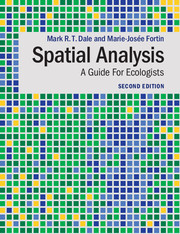Book contents
- Frontmatter
- Dedication
- Contents
- Preface
- 1 Spatial concepts and notions
- 2 Ecological and spatial processes
- 3 Points, lines and graphs
- 4 Spatial analysis of complete point location data
- 5 Contiguous units analysis
- 6 Spatial analysis of sample data
- 7 Spatial relationship and multiscale analysis
- 8 Spatial autocorrelation and inferential tests
- 9 Spatial partitioning: spatial clusters and boundary detection
- 10 Spatial diversity analysis
- 11 Spatio-temporal analysis
- 12 Closing comments and future directions
- References
- Index
9 - Spatial partitioning: spatial clusters and boundary detection
Published online by Cambridge University Press: 05 September 2014
- Frontmatter
- Dedication
- Contents
- Preface
- 1 Spatial concepts and notions
- 2 Ecological and spatial processes
- 3 Points, lines and graphs
- 4 Spatial analysis of complete point location data
- 5 Contiguous units analysis
- 6 Spatial analysis of sample data
- 7 Spatial relationship and multiscale analysis
- 8 Spatial autocorrelation and inferential tests
- 9 Spatial partitioning: spatial clusters and boundary detection
- 10 Spatial diversity analysis
- 11 Spatio-temporal analysis
- 12 Closing comments and future directions
- References
- Index
Summary
Introduction
In order to understand ecological processes at multiple scales, ecological studies are often carried out over large regions (see Chapter 8). By doing so, most study areas include ecological processes that can act at different spatial and temporal scales (Dungan et al. 2002). In such cases, it is unlikely that the standard assumption of stationarity (i.e. the same mean, variance and isotropy; see Chapters 1 and 2) is valid. To analyse ecological data from large regions in a meaningful way, the region should therefore be partitioned into smaller, more homogeneous areas (i.e. patches) that are more likely to be governed by the same ecological process and hence stationary. Stratifying a region can also be useful for monitoring and managing resources by informing locally appropriate adjustments. There are two main approaches to spatially partition a region:
(1) grouping adjacent locations that have similar values of the indicator variable(s) by generating spatial clusters (Figure 9.1), or
(2) dividing the whole region into subareas, based on their degree of dissimilarity, by delineating boundaries between different areas (Figure 9.2).
- Type
- Chapter
- Information
- Spatial AnalysisA Guide For Ecologists, pp. 244 - 277Publisher: Cambridge University PressPrint publication year: 2014



